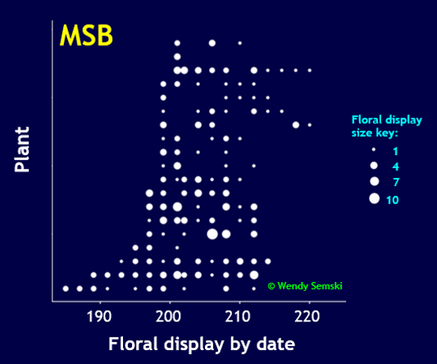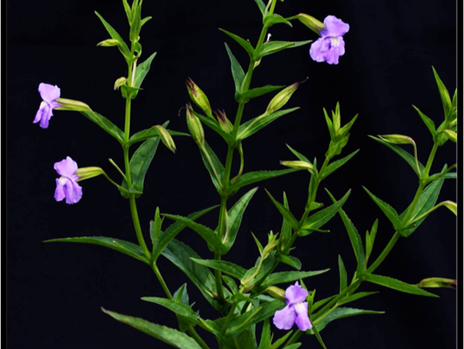Hello! I am a plant evolutionary ecologist
at UW-Milwaukee, USA
at UW-Milwaukee, USA
|
My name is Wendy Semski and I am a PhD candidate in the lab of Dr. Jeff Karron. My research focuses on understanding how patterns of flower deployment influence plant mating in monkeyflower (Mimulus ringens). This work is especially important in the face of climate change because plants' response to altered environmental conditions results in novel flowering times and patterns. |
Flowering phenology is the timing and duration of the reproductive period of angiosperms, and is critical for reproductive success and fitness. Plants must flower during the time when environmental conditions are optimal, and for many species, they must also match their flowering phenology with the activity of their pollinators. Flowering phenology is influenced by temperature, photoperiod, and moisture. Climate change has resulted in a decoupling of these environmental factors so that plants experience novel flowering conditions. It is critically important, therefore, to tease apart the environmental and genetic factors associated with the initiation and progression of flowering.
Watch my recorded talk for Asilomar 2021 below!
There is marked variation in when individuals within a population begin to flower and in how their flowering progresses over the season (called the flowering schedule). This variation may affect patterns of gene flow, which shape the genetic structure of populations. For example, plants that begin to flower early in the season are unable to mate with plants that flower later, and this is especially likely if flowering duration is short. Consequently, these plants may have limited mating opportunites and therefore mate assortatively. When few mates are available, matings are more likely to occur with inferior individuals, reducing their fitness through decreased offspring quality.
However, variation in the onset of flowering does not tell the whole story. Individuals within a population may deploy their flowers on very different schedules, leading to varying floral abundance. Asynchronous flowering is more likely when flowers are deployed sporadically and increases the probability of mating with plants with similar flowering patterns. If these patterns are heritable, then it is probable that these matings will occur with more closely related individuals. This can lead to fine-scale genetic structure and population divergence.
There is marked variation in when individuals within a population begin to flower and in how their flowering progresses over the season (called the flowering schedule). This variation may affect patterns of gene flow, which shape the genetic structure of populations. For example, plants that begin to flower early in the season are unable to mate with plants that flower later, and this is especially likely if flowering duration is short. Consequently, these plants may have limited mating opportunites and therefore mate assortatively. When few mates are available, matings are more likely to occur with inferior individuals, reducing their fitness through decreased offspring quality.
However, variation in the onset of flowering does not tell the whole story. Individuals within a population may deploy their flowers on very different schedules, leading to varying floral abundance. Asynchronous flowering is more likely when flowers are deployed sporadically and increases the probability of mating with plants with similar flowering patterns. If these patterns are heritable, then it is probable that these matings will occur with more closely related individuals. This can lead to fine-scale genetic structure and population divergence.
The number of flowers open simultaneously on an inflorescence, called the daily floral display, affects the amount of among-flower, within-plant self-fertilization that occurs because pollinators are more likely to move frequently between flowers on the same plant. Selfing can be advantageous if mates are hard to find, but high levels of selfing causes the accumulation of genes that cause birth defects in the population. Therefore, producing few flowers at a time (but flowering for a long period) may be an adaptation to decrease this kind of selfing, and may be reflected in their branching architecture and patterns of bud formation.
There is a critical need to tease apart the genetic and environmental factors that influence flowering patterns. This can be done by implementing a "common garden" study, where plants from different populations are grown in the same environment and then measured. If this is done well, any differences between plants must be due to genetic differences.
My research goals are:
My research goals are:
- To understand the extent of variation in flowering phenology and patterns of flower deployment in a common garden
- To determine if there is a relationship between floral display size and population selfing rates
- To discover whether individual flowering schedules can be predicted based on plant architecture and patterns of bud formation






